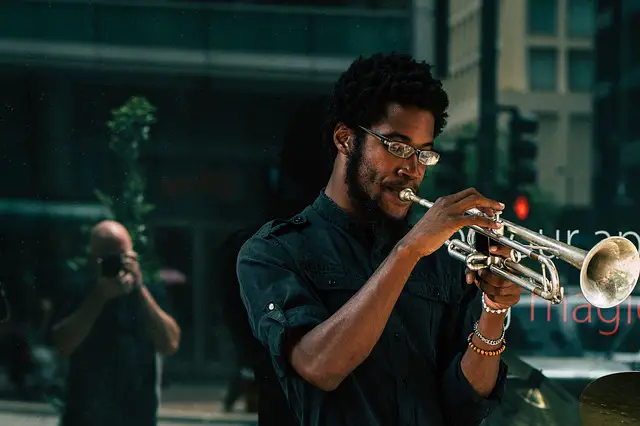Bugle calls are traditionally played at military funerals because of the solemn atmosphere they create. However, things were not always so. Taps was the military’s traditional ‘lights out’ song. Bugle calls, like “Taps,” are signals, not songs. Therefore, there is no lyric to go along with it. Many bugle calls have lyrics attached to them to help remember them, although these are not the lyrics. In this article, we’ll quickly review how to play taps on trumpet and everything you need to know about it.
How To Play Taps On Trumpet
Step 1: In 4/4 time, the beat is counted slowly. The standard notation for “Taps” is in C major, 4/4 time. The sombre mood of the song calls for a slow, consistent tempo (e.g., quarter note = 50 beats per minute).
If you have access to one, practising with a metronome can be helpful.
Step 2: Do a G-G-C while keeping the C held down. A dotted eighth note G and a sixteenth note G serve as pick-up notes for the first beat of the song. Just above them is a dotted quarter note C held for three beats, completing the pattern.
Step 3: To play, hold the E and then play G, C, and G. The identical rhythmic pattern as before, but with different notes, is repeated on the fourth beat of the first measure.
Step 4: To play this, press G, C, and E three times, and then hold the final E. Next, the previously established G-C-E pattern is restarted multiple times, albeit at varying tempos. Play a dotted eighth note G, a sixteenth note C, and a quarter note E (held for only one beat) on the fourth beat of the second measure.
Repetition of the G-C-E (quarter note) pattern is requested. Play the same G-C-E pattern, but this time hold the E (now a dotted quarter note) for three beats instead of just one.
Step 5: It goes C-E-G (in ascending order), E-C-G (in descending order), and then holds the final G (in descending order). At the end of the fourth bar, the music builds to a brief climax. The patterns you have been using up till now will not apply here.
Step 6: Start with a C hold and then go to G-G-C. To close out the tune, return to the opening pattern. You should play a low G dotted eighth note, a G sixteenth note, and a C dotted quarter note, holding the last note for three beats.
Well done, you have just finished playing “Taps.”
It is frequently performed under stressful conditions, such as at funerals for members of the armed forces or law enforcement. Because of these factors, it can be rather challenging to perform well for players who do not have significant prior expertise in the game.
What Are The Notes For Playing Taps?
Since the middle of the 1800s, the playing of “Taps” has been accompanied by the lowering of the American flag during end-of-day festivities and funerals for military personnel. The majority of renditions of the song only contain a handful of notes, specifically the C major triad, which consists of the notes G, C, E, and G.
What Key Should Taps Be Played In?
The “original” key to Taps does not exist. If you are playing an instrument, taps should be played in the key of the instrument you are currently using. I would wager that either a Bb or C was used by the first player of Taps, if asked. Currently, for a trumpet, that’ll be predominantly the C major.
Do Taps have to be played on a trumpet?
In theory, “Taps” could very well be performed on any musical instrument. The music can be played by anyone who can play a whole C major scale. However, “Taps” is typically played on trumpet or bugle, and this remains the case for the vast majority of modern military occasions.
Is Taps Just For The Military?
The Army formally approved the song in the late 1800s to be played at funerals and memorial services for soldiers killed in action. The 24 sombre notes of “Taps” are played today in honour of the fallen from the Army, or any of its sister organisations.
Why Is It Called Taps?
In its early days, it was a practice carried out by British troops stationed in the Netherlands. These soldiers took their inspiration from a local tradition known as taptoe, which is equivalent to what people in the United States refer to as a military tattoo.
Taptoe was another term for the end of the day, but its origins lie in the fact that it was originally employed as a signal to indicate that beer taps needed to be turned off, and therefore the day was considered to end with a tap.
A soldier’s day would end with a roll call, and they would respond to the call of Tattoo to gather together.
What’s The Story Behind Taps?
Taps were first used as a signal to turn off the lights. The standard infantry cry for “Extinguish Lights” was established in French-derived Infantry handbooks up till the start of the Civil War. For his brigade, Major General Daniel Adams Butterfield altered the tune of “Taps” in July of 1862.
How Hard Is It To Play The Taps?
It is worth emphasising that learning to play Taps on the trumpet is not something that can be accomplished overnight. You need serious motivation, plenty of time and effort, and a high-quality instrument. Getting a trumpet and taking lessons from a trained trumpeter is your best bet.
What Does The Song Taps Represent?
The Army was the organisation that originally used the melody in the late 1800s for funerals and memorial events honouring service members. Each year, in remembrance of those who served in the United States Armed Forces in any of its five branches — the Army, the Navy, and their sister organisations — a sequence of 24 sombre notes is played.







